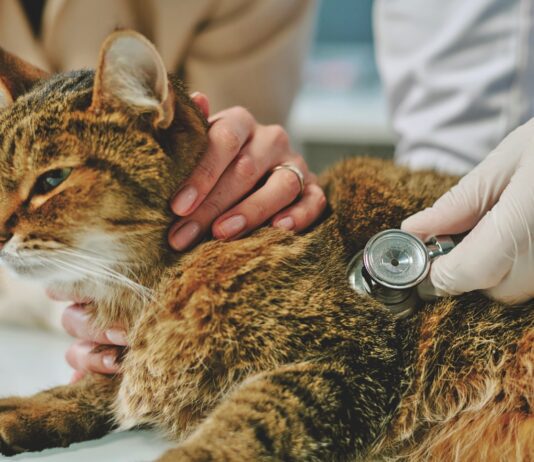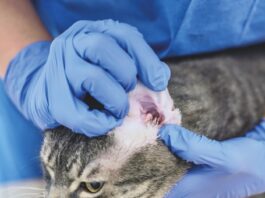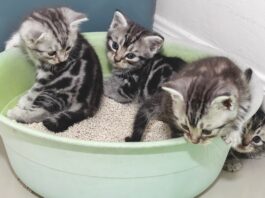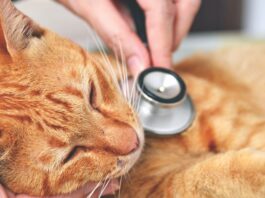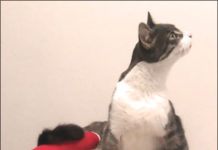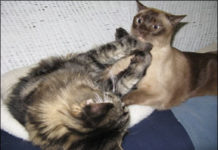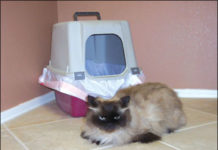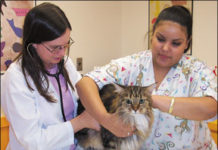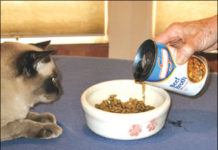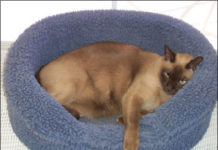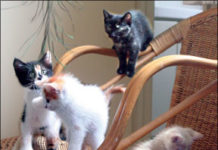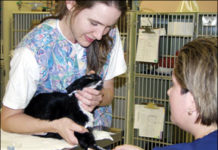Short Takes: 09/08
While the world holds its breath to see if the highly pathogenic avian flu virus H5N1 mutates enough to spread from person to person, German scientists wondered if the average house cat could have a role. An article in the Journal of Feline Medicine and Surgery (Vol. 10 Issue 4: "Prevalence of influenza H5N1 virus in cats from areas with occurrence of highly pathogenic avian influenza in birds"), gave the results of surveys that covered 171 cats in Austria and Germany. The study was presented "to learn more about the role of cats in the spread of the virus and about the risk posed to cats." They were looking for a good "sentinel" animal among mammals, to give an early warning - the way caged canaries in coal mines used to warn of poisonous gases.
Broken Bones: A Threat to Indoor and Outdoor Cats
Despite their typically strong, agile, and resilient bodies, cats are subject to a wide variety of musculoskeletal disorders - diseases and injuries affecting the complex structure of bones, muscles, tendons and ligaments that give shape to their bodies and enable them to move about. Fortunately, most of these disorders - such as congenital malformations, inflammatory diseases, and tumorous growths - are relatively rare in cats. Less rare by comparison are bone fractures that result from traumatic events, such as when a cat is hit by a car, for example, or falls from a tree. A fracture can occur when any physical force applies sudden and excessive pressure on a bone until it snaps at its weakest point.
Abscesses: Signs of Trouble
For several days, your good old cat has been acting oddly, lolling about the house, uncharacteristically lethargic, off his food and seemingly depressed. Then one evening, while stroking his back to comfort the mysteriously dispirited animal, you notice a smallish but alarming lump just to the side of his tail. Although you touch the lump ever so gently, he reacts with a howl, hisses, leaps from your lap and scurries to a dark corner. The lump you discovered is quite possibly an abscess, and although your touching it caused the poor animal intolerable discomfort, its a good thing that you spotted it. The sensitive swelling may indicate that the cat has an infection of some sort, which would explain his sluggish behavior of late, and prompt veterinary care is in order.
Ask Elizabeth: 08/08
Hmm, if I had known about this disease during my days on the farm, I might not have been so keen on eating birds myself! Songbird fever is an uncommon disease of cats, that results from eating Salmonella-infected birds or from spending time in bird feeding areas (and ingesting contaminated bird feces). Symptoms of songbird fever appear suddenly two to four days after exposure, last two to seven days, and include high fever, anorexia, depression, diarrhea (which may contain blood) and vomiting. The diagnosis can be confirmed by bacterial culture of the feces or blood. Songbird fever is fatal in up to 10 percent of cases.
Caring for the Constipated Cat
Your cat has always been a creature of habit when it comes to moving his bowels. Twice a day - once in the morning and once in the evening - he shuffles to his litter box and gracefully relieves himself. If Plato should ever break that pattern and not move his bowels for a day or two, youd be wise to have him examined by your veterinarian right away. Its possible that he is constipated, a condition that will probably be easily relieved if spotted early. Without diagnosis and proper treatment, however, his constipation could progress rapidly to a serious threat to his health, perhaps his life.
Understand Skin Disorders
The function of your cats skin extends well beyond its role as the matrix for the animals lustrous haircoat. In a healthy feline, the skin also works, for example, as a barrier against invasion by harmful microorganisms. It serves as a watertight seal, retaining an animals body fluids and preventing dehydration. And it insulates an animals internal organs against the outside worlds extremes of heat and cold. Despite its normally durable structure, however, every cats skin is subject to a wide array of disorders, most of which are minor and readily treatable. But some untreated skin conditions can rapidly progress to a serious, even lethal, stage, with systemic implications. Considering the dangerous potential of virtually any untreated skin condition, William H. Miller Jr., VMD, a professor of dermatology at Cornell Universitys College of Veterinary Medicine, strongly urges cat owners to practice what he terms "preventive maintenance." Keep an eye out, he advises, for any suspicious scratching or hair loss that might suggest the presence of a parasitic, bacterial or fungal infection. Take note of any skin wounds, growths or swollen areas on the skin, no matter how inconsequential they may seem. And seek the counsel of a veterinary dermatologist if any such suspicious signs appear.
Feeding the Stressed Cat
Fires in California last fall caused more than 300,000 residents and their pets to flee their homes. This spring, an estimated 1,000 dogs and cats in Iowa, Indiana and Missouri were temporarily relocated or found stranded as a result of recent flooding in these areas. And dont forget Hurricane Katrina, which displaced an estimated 50,000 animals in 2005. A house pet that suddenly finds itself in a noisy, unfamiliar shelter, or worse yet, barely clinging to life from the peak of a rooftop, suffers from a high level of stress. Though your feline hopefully will never experience this level of stress, the physical responses to stress - whatever the cause - are similar. So, whether the cause of a cats stress is a catastrophic disaster or the addition of a new kitten into the home, much can be learned from those who routinely work with stressed felines and applied to our house cats - particularly when it comes to feeding and nutrition.
Short Takes: 08/08
With 28.7 percent of all adult American cats classified as "overweight" and 6.4 percent as clinically obese, things only get worse with age. Among cats between five and 11 years of age, fully 44 percent are either overweight or obese. Just in time (we were about to have Frannie, the ShortTakes office kitty, fitted for running shoes) comes this report in the Journal of the American Veterinary Medical Association (Vol. 232, No. 11): "Nutraceuticals and dietary supplementation for the management of obese and overweight pets." The study looked at everything from omega-3 fatty acid supplementation, amylase inhibitors and DHEA (dehydroepiandrosterone) to L-carnitine, CLA (conjugated linoleic acid) and dietary phytoestrogens. Some, such as diacylglycerol, make a computers spell-checker burp. And not all, including the last one, have been tested on cats.
Short Takes: 07/08
Theres more finger-pointing toward pets as "reservoirs" of MRSA, the hard-to stop bacterium methicillin-resistant Staphylococcus aureus. This time the New England Journal of Medicine (Vol. 358, No. 11) reports on a German woman who suffered deep abscesses and necrotizing pneumonia. The womans cat seemed healthy enough - until tests found the pet infected with a form of MRSA that is extremely rare in humans, spa-type t131 MRSA. Doctors at the Bavarian Food and Health Safety Authority said: "The abscesses in our patient healed only after antibiotic treatment of the cat. It remains unclear whether the cat was the source of the patients infection or vice versa . . . We conclude that pets could be considered as possible household reservoirs of MRSA that can cause infection or reinfection in humans."
The Threat of Panleukopenia
Among all agents of feline illness and mortality, few if any are more pernicious - especially to kittens - than feline panleukopenia virus (FPV). Disease resulting from infection with this virus is called panleukopenia - from the Greek words for all types (pan) of white blood cells (leuko) that are greatly reduced in number (penia). The disease is also known in some circles as "distemper," a misnomer, notes Fred Scott, DVM, PhD, a professor emeritus of virology in Cornell Universitys College of Veterinary Medicine and founding director of the Cornell Feline Health Center. "Distemper" refers to a respiratory disease, he explains, and there is no respiratory component to feline panleukopenia. Cats become infected with FPV - which is classified as a parvovirus - by living in an environment that is contaminated with it or by coming in contact with the urine, feces, saliva or nasal secretions of a cat that is already infected. "Panleukopenia is highly contagious," says Dr. Scott. "It takes only a small amount of the virus to cause infection, and the amount of virus shed by an infected cat is tremendous - probably anywhere from one billion to 10 billion viral particles per gram of fecal matter, urine or other secretions."
Can Your Cat Tell Time?
You have to get up at 6:00 a.m. during the week. But you dont even have to set your alarm, because your cat comes in and licks your fingers or jumps up and purrs on your chest just before the wake-up hour. Thats a pretty nice way to wake up, actually - unless it happens to be Saturday morning and you were planning on sleeping in. But weekday or weekend, your old-faithful feline is there just the same, licking your fingers and purring on your chest just before 6:00 a.m. How do cats do it? Do they really sense what hour it is, or is it something else? Alas, this is one of the many enduring mysteries about cats, says Larry Myers, DVM, PhD, of the Auburn University School of Veterinary Medicine in Alabama. "Some of what appears to be cats telling time is entrainment. Its routine reinforced. Cats very quickly become aware of when human family members wake up, eat, go out and come home," says Dr. Myers, whose 18-year-old female cat wakes him at 6:00 a.m. daily for breakfast (hers, not his).
Diagnosis: Feline Anemia
Veterinarians generally recommend that all cats undergo a thorough physical examination at least once a year until they have reached seven or eight years of age, and twice annually thereafter as they progress into their senior years. The exam should include a complete blood count (CBC), a procedure that can reveal or at least suggest the presence of many feline health disorders. The importance of the CBC should not be underestimated. Among other things, a CBC will determine the concentration of red blood cells (erythrocytes) in a drop or two of blood. The procedure will also reveal the density of hemoglobin, an important constituent of each erythrocyte.

